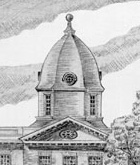The Dome and Lightning Rod
The First Dome: 1769 - 1774
 Just as the Articles of Confederation did not
effectively govern the country, the first dome of the
State House at Annapolis did not survive more than a
decade of Maryland weather. In 1769, the General
Assembly of Maryland passed an act to erect a new state
house, securely covered with slate tile or lead. The
architect was Joseph Horatio Anderson, and the
undertaker or builder of the project was Charles
Wallace. According to William Eddis in 1773, the work
was carried on with great dispatch and when completed
would "be equal to any public edifice on the American
continent."
Just as the Articles of Confederation did not
effectively govern the country, the first dome of the
State House at Annapolis did not survive more than a
decade of Maryland weather. In 1769, the General
Assembly of Maryland passed an act to erect a new state
house, securely covered with slate tile or lead. The
architect was Joseph Horatio Anderson, and the
undertaker or builder of the project was Charles
Wallace. According to William Eddis in 1773, the work
was carried on with great dispatch and when completed
would "be equal to any public edifice on the American
continent."
The exact date of the completion of the first dome or
cupola is not known but evidence suggests that it was
completed by the year 1774. In a 1773 Act of Assembly,
Charles Wallace was instructed to fix an iron rod
pointed with silver or gold at least six feet above the
cupola. The General Assembly also recommended that the
roof be covered with copper because the slate originally
specified would require frequent repairs and cause other
inconveniences. According to Charles E. Peterson's
"Notes on Copper Roofing in America to 1802", it was
more than likely that local copper was put on the roof
to advertise the new industry of Maryland.